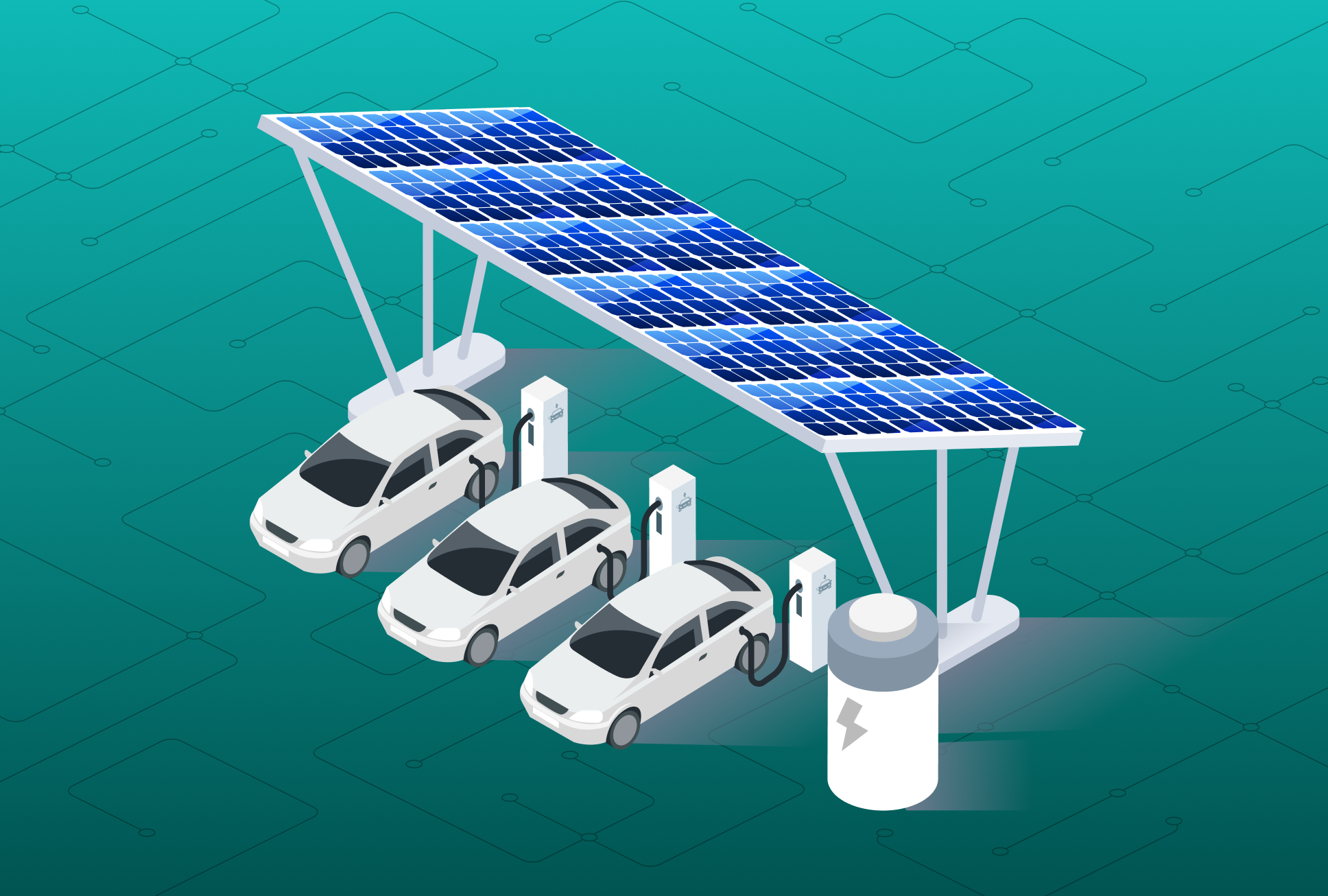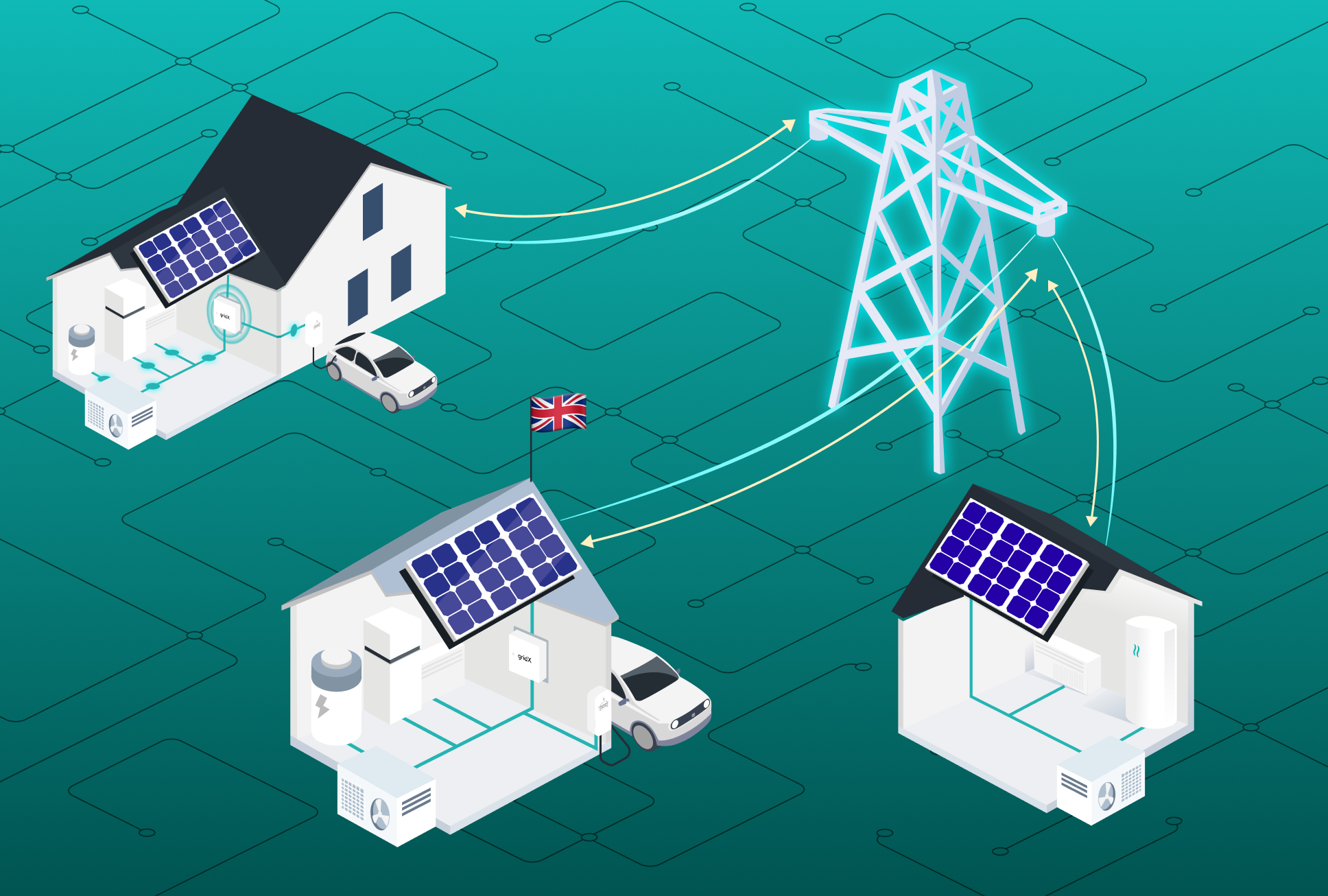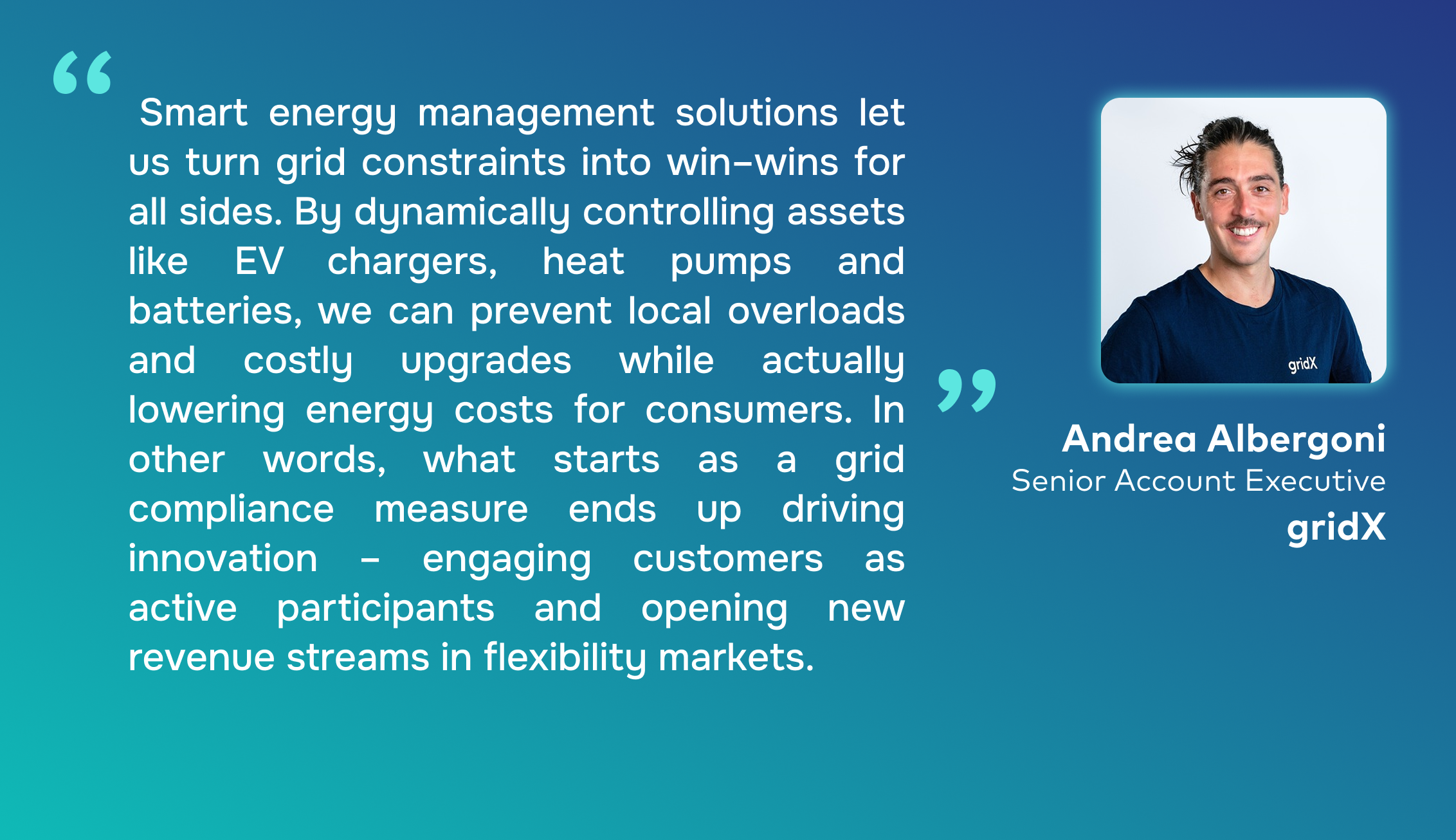Understanding G100: UK grid regulations on export and import limitations
At its core, G100 manages grid congestion by capping how much power a site can import or export. It’s a local congestion management grid regulation ensuring stability in specific areas of the UK’s electricity distribution network, where demand and generation levels constantly shift.
G100 ensures electric vehicle (EV) chargers, heat pumps, solar photovoltaic (PV) systems and batteries operate within agreed limits, protecting the grid while maximizing usable energy.
If a site generates more power than permitted, the Customer Limitation Scheme (CLS) – the core mechanism under G100 – monitors and automatically caps export or import. When paired with an active (H)EMS, excess energy can be redirected to batteries or local loads instead of being wasted, while high demand can be throttled to stay within limits.
Set out by the Energy Networks Association (ENA), G100 defines how CLS should function through a mix of hardware and control software. The latest version, Issue two, covers both export and import, reflecting the growing impact of EVs and heat pumps on local networks.
G100 complements G98 and G99, which govern generator connections. Storage systems must meet all regulatory requirements – G98/G99 when exporting and G100 when managing power flow. These standards act as the safeguard that keeps every site, from solar homes to EV charging hubs, within safe operating limits.
As electrification accelerates, G100 compliance will become standard for both homes and e-mobility sites. Beyond ensuring compliance, it lays the groundwork for scalable, flexible energy management – shaping how businesses handle multi-energy assets and charging infrastructure.
Why does G100 matter?

As the UK accelerates toward electrification, local networks are reaching their capacity limits. Without control systems, peaks from solar exports or mass EV charging could overwhelm the grid. G100 provides the safeguard, setting strict import and export limitations at each site to maintain grid stability.
G100 is critical for all actors across the energy value chain – from manufacturers to energy providers to e-mobility site operators. It effectively mandates the intelligent integration and control of assets like solar PV, batteries, heat pumps andE V chargers, so that they always stay within approved grid limits. For charge point operators (CPOs), grid compliance enables high-power charging stations to expand without triggering costly network reinforcements.
By embedding G100 compliance into EMS platforms, energy companies can not only meet regulations but also manage multiple assets efficiently, support grid reliability and open the door to new revenue opportunities through flexibility services.
Business and operational impacts of G100 compliance
For energy companies, project developers and installers working with HEMS and e-mobility sectors, G100 compliance is not optional. It’s mandatory. But beyond regulation, it’s becoming a strategic enabler for energy players.
A HEMS ensures that multi-assets households – with solar PV, batteries and heat pumps – operate intelligently within grid limits, turning compliance into a foundation for scalable, revenue-generating energy management. An EMS enables e-mobility operators to manage large charging sites efficiently, ensuring each EV charger draws power within approved limits while maximizing station uptime and profitability.

Streamlined connections and grid access
G100 compliance simplifies project approvals and accelerates deployment. By setting clear import and export caps, businesses can integrate solar, storage and EV charging without triggering expensive grid reinforcements or long DNO approval processes. For e-mobility operators, this means rolling out high-capacity charging hubs faster and at lower cost.
Grid stability and reliability
G100-compliant systems actively stabilize local networks. Through automated control, HEMS and EMS platforms balance consumption and generation, prevent overloads and support overall grid reliability. For operators managing EV fleets or charging infrastructure, this translates to consistent uptime and a stronger reputation for dependable, grid-friendly performance.
Customer trust and future-proofing
G100-certified systems are no longer just the preferred option. They’re the only scalable path forward. Non-compliant setups require DNO exemptions that are slow, expensive and non-replicable. In contrast, G100-ready EMS solutions guarantee reliability, safety and interoperability. They already integrate the communication and control features needed for next-generation smart grids, positioning early adopters for long-term advantage.
Impact on project implementation
Compliance adds complexity. Installers must secure settings, complete DNO documentation and use certified components. Manufacturers have had to redesign or re-certify their products under G100-2. Still, the benefits outweigh the effort: G100 compliance speeds up installations, builds customer confidence and positions EMS providers to lead the transition toward flexible, grid-aligned energy systems.
The role of EMS in G100 compliance and smart grid management
Energy management systems (EMS) are central to how energy players achieve and scale G100 compliance. As electrification accelerates, these systems coordinate multiple assets so that homes and charging sites operate intelligently within their agreed grid limits.
While single devices like inverters or chargers may individually meet G100 requirements, compliance becomes more complex when several assets interact. A HEMS or EMS manages this complexity by ensuring that each device responds dynamically to grid conditions while maximizing available energy and maintaining user comfort. In essence, G100 defines the rules, while an EMS enforces them in real time.

HEMS: Intelligent control for export limitation and grid compliance
Instead of simply shutting off when reaching an import or export cap, a G100-compliant HEMS – both the EMS software and hardware components must be certified, and re-certified following firmware updates – optimizes how home energy assets behave. When solar production exceeds export limits, the system automatically redirects excess power to a battery or an EV charger or increases local consumption through flexible loads. When nearing import limits, it can slow charging, delay heating or adjust consumption to stay within the allowed capacity.
This level of control ensures full grid compliance without user intervention. Beyond regulation, it allows homeowners to use more of their self-generated energy locally and prepare for future flexibility markets where grid-responsive behavior is rewarded. A HEMS transforms static export limitation into intelligent energy use, aligning household comfort and sustainability with network stability.
EMS: Balancing EV charging with grid limits
For e-mobility operators, an EMS ensures charging sites remain within permitted import and export thresholds. It prevents EV chargers from overloading the grid connection by actively balancing loads across multiple charging points. If a site nears its import limit, the EMS slows or schedules charging intelligently while maintaining uptime and user satisfaction.
An EMS doesn’t just protect local grid connections, it also enables scalable business operations. By ensuring continuous grid compliance, operators can expand charging capacity without triggering grid reinforcements or lengthy DNO approval processes. Over time, this creates operational flexibility and supports participation in smart grid initiatives such as demand response or dynamic pricing.
Turning compliance into flexibility
In the UK, a smart energy management system turns G100 compliance from a regulatory requirement into a flexibility enabler. By managing assets within grid limits, it gives utilities and aggregators access to controllable capacity that can be temporarily adjusted – for example, reducing exports during peak hours or limiting imports when demand surges.
Utilities or aggregators can request a smart energy management system to pause charging or reduce export as part of a flexibility service. The system executes these actions locally within its G100-certified control logic, maintaining full compliance while supporting the grid and allowing users to earn flexibility revenue.
This two-way coordination transforms G100 from a static restriction into an active flexibility framework, paving the way for new business models around energy trading, load shifting and dynamic tariffs.
Enabling interoperability and scalability
An EMS also bridges the gap between devices from different OEMs. Many inverter, charger and heat pump manufacturers operate in isolated ecosystems. A local controller, such as the gridBox, enables interoperability by connecting all assets under one compliant, site-wide logic. This is essential for scaling multi-device installations – from homes with solar and EVs to commercial charging hubs, while staying within G100 boundaries.
Transparency and user empowerment
A key advantage of integrating HEMS and EMS is visibility. Without it, users might notice slower charging or lower solar output without understanding the reason. A well-designed interface provides clear insights into how their systems adapt to grid conditions and optimize energy use in the background. This transparency builds trust and turns compliance into a value-added experience, showing users that their energy setup works efficiently, supports the grid and helps them save without requiring active intervention.
Local control is key
G100 requires that compliance actions occur locally, not via cloud control. Whether through a directly wired setup or local LAN/Wi-Fi connection, the system must react instantly to changes in power flow. Cloud-based optimization can support long-term energy management, but real-time G100 compliance depends on certified, locally controlled devices.
Expert insights: Energy management central to G100-enabled flexibility
Andrea Albergoni, Senior Account Executive at gridX, highlights that G100 compliance is no longer just a technical requirement but a strategic opportunity for both home and e-mobility energy management. He explains, “By embedding G100 logic directly into EMS, energy providers can transform homes, buildings and charging sites into flexible grid assets. A smart system continuously balances solar generation, battery storage and EV charging to stay within approved limits, ensuring compliance while optimizing self-consumption. This gives utilities the ability to tap into distributed energy resources for stability, while customers gain efficiency and savings.”

G100 defines the limits, but an energy management system makes those limits work to everyone’s advantage. In homes, a HEMS manages import and export dynamically, redirecting solar surplus to a battery or EV. In the e-mobility sector, an EMS coordinates charging across multiple stations, keeping total demand within site caps while ensuring operational efficiency.
The mutual benefit is clear: utilities get predictable, grid-friendly behavior, while customers and operators extract more value from their assets through flexibility revenue, reduced peak costs and higher system uptime. As Albergoni notes, this alignment between compliance, flexibility and customer experience is what turns G100 from a regulatory burden into a driver of smarter, more resilient energy systems.
Smart energy management is, in effect, the bridge between regulation and innovation, turning static limits into tangible value for actors across the energy value chain.



